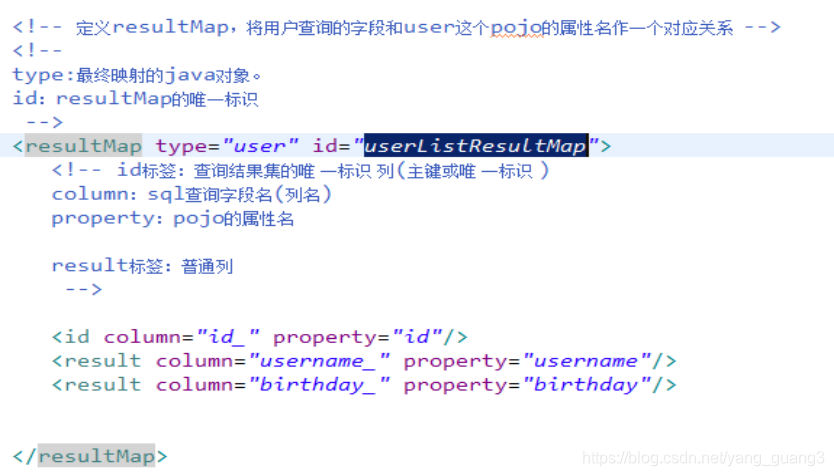1、根据用户名查询用户信息,查询条件放到QueryVo的user属性中,入参传递user对象
<!-- 使用包装类型查询用户
使用ognl从对象中取属性值,如果是包装对象可以使用.操作符来取内容部的属性
-->
<select id="findUserByQueryVo" parameterType="queryvo" resultType="user">
SELECT * FROM user where username like '%${user.username}%'
</select>2、获取用户列表总数
<select id="findUserCount" resultType="int">
select count(1) from user
</select>resultType可以指定pojo将查询结果映射为pojo,但需要pojo的属性名和sql查询的列名一致方可映射成功
如果sql查询字段名和pojo的属性名不一致,可以通过resultMap将字段名和属性名作一个对应关系 ,resultMap实质上还需要将查询结果映射到pojo对象中
resultMap可以实现将查询结果映射为复杂类型的pojo,比如在查询结果映射对象中包括pojo和list实现一对一查询和一对多查询
定义resultMap
由于上边的mapper.xml中sql查询列和Users.java类属性不一致,需要定义resultMap:userListResultMap将sql查询列和Users.java类属性对应起来
<id />:此属性表示查询结果集的唯一标识,非常重要。如果是多个字段为复合唯一约束则定义多个<id />。
Property:表示User类的属性。
Column:表示sql查询出来的字段名。
Column和property放在一块儿表示将sql查询出来的字段映射到指定的pojo类属性上。
<result />:普通结果,即pojo的属性。
3、动态sql
3.1、if语句
<select id="findUserList" parameterType="user" resultType="user">
select * from user
where 1=1
<if test="id!=null">
and id=#{id}
</if>
<if test="username!=null and username!=''">
and username like '%${username}%'
</if>
</select>3.2、Where语句
<select id="findUserList" parameterType="user" resultType="user">
select * from user
<where>
<if test="id!=null and id!=''">
and id=#{id}
</if>
<if test="username!=null and username!=''">
and username like '%${username}%'
</if>
</where>
</select>where语句可以自动处理第一个and
3.3、foreach语句
向sql传递数组或List,mybatis使用foreach解析,如下:
传入多个id查询用户信息,用下边两个sql实现:
SELECT * FROM USERS WHERE username LIKE '%张%' AND (id =10 OR id =89 OR id=16)
SELECT * FROM USERS WHERE username LIKE '%张%' id IN (10,89,16)在pojo中定义list属性ids存储多个用户id,并添加getter/setter方法
<if test="ids!=null and ids.size>0">
<foreach collection="ids" open=" and id in(" close=")" item="id" separator="," >
#{id}
</foreach>
</if>4、Sql重复片段
Sql中可将重复的sql提取出来,使用时用include引用即可,最终达到sql重用的目的,如下:
<select id="findUserList" parameterType="user" resultType="user">
select * from user
<where>
<include refid="query_user_where"/>
</where>
</select>
<sql id="query_user_where">
<if test="id!=null and id!=''">
and id=#{id}
</if>
<if test="username!=null and username!=''">
and username like '%${username}%'
</if>
</sql>注意:如果引用其它mapper.xml的sql片段,则在引用时需要加上namespace,如下:
<include refid="namespace.sql片段”/>5、查询所有订单信息,关联查询下单用户信息
使用resultType,定义订单信息po类,此po类中包括了订单信息和用户信息:
public class OrdersCustom extends Orders {
private String username;// 用户名称
private String address;// 用户地址
get/set。。。。
}OrdersCustom类继承Orders类后OrdersCustom类包括了Orders类的所有字段,只需要定义用户的信息字段即可
<!-- 查询所有订单信息 -->
<select id="findOrdersList" resultType="cn.itcast.mybatis.po.OrdersCustom">
SELECT
orders.*,
user.username,
user.address
FROM
orders, user
WHERE orders.user_id = user.id
</select>小结:定义专门的po类作为输出类型,其中定义了sql查询结果集所有的字段。此方法较为简单,企业中使用普遍
另外一种方法:使用resultMap,定义专门的resultMap用于映射一对一查询结果。
在Orders类中加入User属性,user属性中用于存储关联查询的用户信息,因为订单关联查询用户是一对一关系,所以这里使用单个User对象存储关联查询的用户信息。
xml文件:
<!-- 查询订单关联用户信息使用resultmap -->
<resultMap type="cn.itheima.po.Orders" id="orderUserResultMap">
<id column="id" property="id"/>
<result column="user_id" property="userId"/>
<result column="number" property="number"/>
<result column="createtime" property="createtime"/>
<result column="note" property="note"/>
<!-- 一对一关联映射 -->
<!--
property:Orders对象的user属性
javaType:user属性对应 的类型
-->
<association property="user" javaType="cn.itcast.po.User">
<!-- column:user表的主键对应的列 property:user对象中id属性-->
<id column="user_id" property="id"/>
<result column="username" property="username"/>
<result column="address" property="address"/>
</association>
</resultMap>
<select id="findOrdersWithUserResultMap" resultMap="orderUserResultMap">
SELECT
o.id,
o.user_id,
o.number,
o.createtime,
o.note,
u.username,
u.address
FROM
orders o
JOIN `user` u ON u.id = o.user_id
</select>这里resultMap指定orderUserResultMap。
association:表示进行关联查询单条记录
property:表示关联查询的结果存储在cn.itcast.mybatis.po.Orders的user属性中
javaType:表示关联查询的结果类型
<id property="id" column="user_id"/>:查询结果的user_id列对应关联对象的id属性,这里是<id />表示user_id是关联查询对象的唯一标识。
<result property="username" column="username"/>:查询结果的username列对应关联对象的username属性
6、一对多查询
查询所有用户信息及用户关联的订单信息
用户信息和订单信息为一对多关系,使用resultMap实现如下:
在User类中加入List orders属性
xml文件:
<resultMap type="cn.itheima.po.user" id="userOrderResultMap">
<!-- 用户信息映射 -->
<id property="id" column="id"/>
<result property="username" column="username"/>
<result property="birthday" column="birthday"/>
<result property="sex" column="sex"/>
<result property="address" column="address"/>
<!-- 一对多关联映射 -->
<collection property="orders" ofType="cn.itheima.po.Orders">
<id property="id" column="oid"/>
<!--用户id已经在user对象中存在,此处可以不设置-->
<!-- <result property="userId" column="id"/> -->
<result property="number" column="number"/>
<result property="createtime" column="createtime"/>
<result property="note" column="note"/>
</collection>
</resultMap>
<select id="getUserOrderList" resultMap="userOrderResultMap">
SELECT
u.*, o.id oid,
o.number,
o.createtime,
o.note
FROM
`user` u
LEFT JOIN orders o ON u.id = o.user_id
</select>collection部分定义了用户关联的订单信息。表示关联查询结果集
property=“orders”:关联查询的结果集存储在User对象的上哪个属性。
ofType=“orders”:指定关联查询的结果集中的对象类型即List中的对象类型。此处可以使用别名,也可以使用全限定名。
<id />及<result/>的意义同一对一查询










